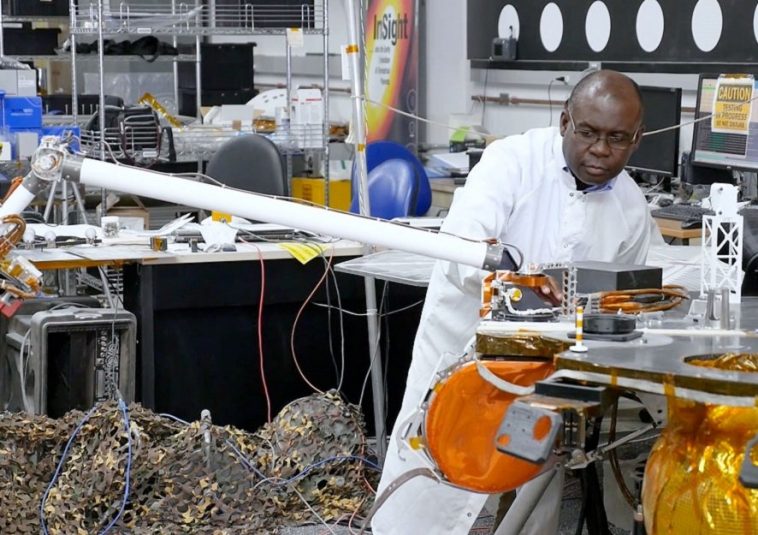TechInAfrica – Ashitey Trebi-Ollennu is a Ghanaian whose dream was to replacing human pilots with robots. He is currently Instrument Deployment Systems Lead on InSight, NASA’s spacecraft that landed on Mars recently. His main responsibility is the mission’s robotic arm mechanism.
When he was just a little boy, Ollennu often stood at his porch and watched planes flew in and out of the airport. He felt fascinated by it and was imagining to replace human involvement in the plane piloting with computers.

With the InSight current mission, Ollennu and his team try to find out how the planets are formed. Therefore, they have to dive deep far from the surface to do so. Like Ollennu said, the core of the planet.
According to Ollennu, the robotic arm main task is to put scientific instruments off the InSight lander onto the surface, “Our responsibility is to pick up the instruments that the scientists are going to use to examine the planets hundreds of millions of miles away.”
The robotic arm is 5’’9 or 1.8 meters long with an attached camera on, providing 3D colors views of the landing site. It’s designed with the ability to locate the seismometer on the surface and place the heat flow probe, a mole that’s able to burrow five meters into the ground. The mission will take about two or three months to set the instrument on the surface. What the robotic arm does now is taking pictures of Planet Mars.
“We’re going to take a selfie of the land. We are going to take the imagery of the workspace, and then we are going to start planning how to get the instrument to the surface,” Said Ollennu via Skype to CNN.
Ollennu obtained his degree at the Department of Aeronautical Engineering, Queen Mary College, University of London, majoring in Avionics. He then obtained his Ph.D. in Control Systems Engineering at Cranfield University in the UK. For his further research in robotics, he then moved to the US, precisely at Carnegie Mellon University in Pittsburgh.
He has worked on several projects related to Mars, including the 2003 Mars Exploration Rover, Phoenix Mars Lander of 2007, Mars Science Laboratory in 2011, and the 2016 Insight Mars Lander.
Through his career as an engineer, he has been awarded in numerous prizes, such as the 2008 NASA Exceptional Engineering Achievement Medal and the 2010 Specialist Silver Award from the Royal Aeronautical Society in the UK.
Ollennu is driven to advance human knowledge, as he explained that: “One of the things that people forget is that prehistoric times across the continent of Africa, Europe, and Asia our forefathers looked to the heavens and mapped the constellations. And what did they do with them? They created calendars so they can know when to harvest, when to plant …they just looked up into space and then they did all this mapping,”
“Humans always look to the heavens to gain knowledge and use that knowledge to make life a little better and that’s exactly what we do at NASA. And that’s exactly what InSight is going to do,” Ollennu said.
He tries to inspire the next generation as well as young scientists and innovators through the Ghana Robotic Academy Foundation that was founded in 1991. The non-profit organization supports school kids to involve in applied science through hands-on robotic workshops and competition across the nation.
“We try to apply theory and put it into practice. So we take the theories that the kids are learning in schools. And then we use it to teach them how to program and they can see that science is not just about theory,” Ollennu said.
The Foundation has shown excellent results as many kids have involved in international robotic competitions such as the World Robotics Olympiad and Robofest. The competitions help the students to sharpen their skills in Science, Computer, Math, Technology, and Engineering.
 We just launched our WhatsApp channel. Want to get the latest news from the Tech in Africa?
We just launched our WhatsApp channel. Want to get the latest news from the Tech in Africa?

